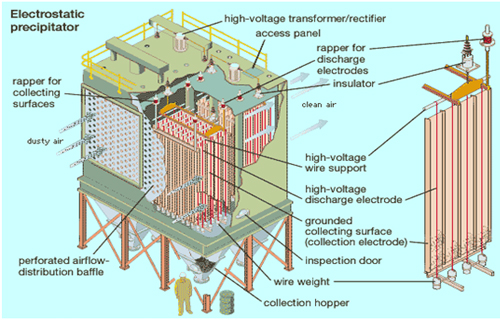HOME :: Electrostatic Precipitator
Electrostatic Precipitator

In contrast to wet scrubbers, which apply energy directly to the flowing fluid medium, an ESP applies energy only to the particulate matter being collected and therefore is very efficient in its consumption of energy (in the form of electricity).
ESPs continue to be excellent devices for control of many industrial particulate emissions, including smoke from electricity-generating utilities (coal and oil fired), salt cake collection from black liquor boilers in pulp mills, and catalyst collection from fluidized bed catalytic cracker units in oil refineries to name a few. These devices treat gas volumes from several hundred thousand ACFM to 2.5 million ACFM (1,180 m³/s) in the largest coal-fired boiler applications. For a coal-fired boiler the collection is usually performed downstream of the air preheater at about 160 °C (320 °F) which provides optimal resistivity of the coal-ash particles. For some difficult applications with low-sulfur fuel hot-end units have been built operating above 370 °C (698 °F).
The original parallel plate–weighted wire designhas evolved as more efficient (and robust) discharge electrode designs were developed, today focusing on rigid (pipe-frame) discharge electrodes to which many sharpened spikes are attached (barbed wire), maximizing corona production. Transformer-rectifier systems apply voltages of 50–100 kV at relatively high current densities. Modern controls, such as an automatic voltage control, minimize electric sparking and prevent arcing (sparks are quenched within 1/2 cycle of the TR set), avoiding damage to the components. Automatic plate-rapping systems and hopper-evacuation systems remove the collected particulate matter while on line, theoretically allowing ESPs to stay in continuous operation for years at a time.

